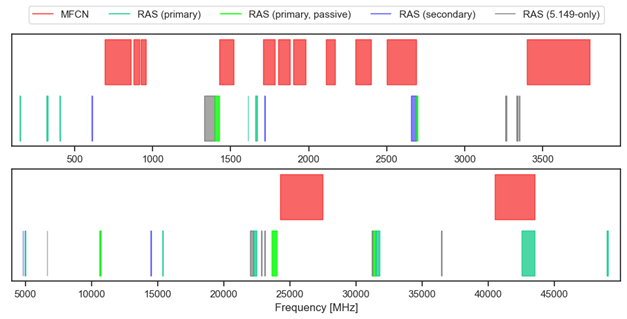
CRAF Update – The battle for the 6 GHz band
by Benjamin Winkel (CRAF Chair, Max-Planck-Institut für Radioastronomie, Germany) and Waleed Madkour (CRAF Frequency Manager, JIVE, the Netherlands)
The Committee on Radio Astronomy Frequencies (CRAF) is an Expert Committee of the European Science Foundation. It aims to provide a cost-effective single voice on frequency protection issues for European radio astronomy observatories and research institutes, achieving a significantly greater impact than that achievable by individual national institutions. By working together European observatories and institutes can profit from synergy effects by covering many more topics and learning from each other. CRAF was founded in 1988 and has since then been engaged with the International Telecommunication Union (ITU), in particular its Radiocommunication Sector (ITU-R), and the European Conference of Postal and Telecommunications Administrations (CEPT) and its European Communications Committee (ECC).
One of the critical issues currently on the agenda of CRAF is the protection of the methanol spectral line within the 6650–6675.2 MHz band. This band already overlaps with several radiocommunication services currently operating in the 6–7 GHz range such as the fixed services (FS) and fixed satellite services (FSS). It is now under further pressure from other services, who are also endeavouring to obtain an allocation at the next ITU-R World Radiocommunication Conference in 2023 (WRC-23). Mobile-fixed communication networks (MFCN, i.e., cell phone networks including 4G and 5G) consider the “mid-band” essential for strategic advantages offering both capacity and coverage. However, several European countries also seem to prefer to establish WiFi in the upper part of the 6–7 GHz band after the lower 500 MHz of the band has already been assigned to WiFi recently.
MFCN represents the greatest threat to any RAS station in Europe because of the high population density, even in “remote” areas. Cell phone base stations emit so much power that radio astronomy observations in the MFCN bands are impossible unless separation distances in excess of hundreds of kilometres are in place (which is never a practical solution for the case of Europe). Even state-of-the-art RFI mitigation will not be able to remove the negative impact of these signals, simply because of the huge difference in relative incident power levels of MFCN signals compared with astronomical signals. Interferometric observations, including VLBI, would also be very considerably impacted.

Figure 1 shows the radio astronomy and cell-phone allocations below 50 GHz. It has to be noted that below 4 GHz, one third of the spectrum is already allocated to MFCN, whereas radio astronomy has a mere 5%. Even at higher frequencies there is increasing demand for spectrum by new emerging technologies and future 6G networks.
The 2019 World Radiocommunication Conference (WRC-19) has already allocated many GHz of new bandwidth to cell phones in the mm-wave spectrum. However, there is an insatiable hunger for even more. In the current study cycle, as preparation for WRC-23, the possibility of allocations of several hundreds of MHz in the “mid-band” (between approximately 3 and 11 GHz) is being studied. Currently, the probability that administrations will identify the upper 6 GHz band for use of cell-phone networks is high. This might result in the total loss of the methanol band (6650–6675.2 MHz) in Africa and Europe, which is of utmost importance to radio astronomy. The methanol band is not allocated to the RAS but only protected via the Footnote No 5.149 in the ITU-R Radio Regulations, which urges administrations to protect radio astronomy facilities in the national licensing processes. This, however, would not suffice for European observatories as CRAF’s compatibility calculations have demonstrated that protection distances of several hundreds of kilometres might be required; see Figure 2.

The current unwillingness to protect the methanol band at ITU-R is somewhat surprising, if one considers the historical context. Potential new allocations in the 6–7 GHz regime have been discussed at almost every WRC in the past two decades and protection of the radio astronomy service was always considered. During the current study cycle, however, several administrations have successfully stopped considerations of technical contributions from astronomy organisations on this topic using procedural arguments.
For the CEPT, which will formulate a common position on this topic before the WRC-23, the situation is not yet finally resolved. CRAF is also currently undertaking studies for the WiFi scenario. First results indicate that necessary separation distances would be significantly smaller for WiFi devices. On the other hand, the regulatory situation is quite different: whereas in many European countries, MFCN base stations are individually licensed (i.e., the network agencies have control over the base station), WiFi is often licence-exempt. Thus, policing is more difficult, should it come to harmful interference.
Despite the challenging situation, CRAF will continue working towards the incorporation of the necessary regulations for the protection of the methanol line associated with any new allocations to either MFCN or WiFi. The regional CEPT positions for WRC-23 will soon have to be finalised, but even beyond this date, CRAF and the European radio astronomical community as a whole need to continue lobbying administrations to consider radio astronomy protection. Final decisions on this and other topics will only be made at WRC-23 itself.